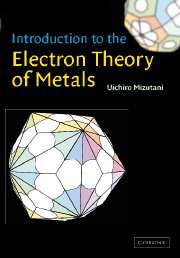Book contents
- Frontmatter
- Contents
- Preface
- 1 Introduction
- 2 Bonding styles and the free-electron model
- 3 Electrons in a metal at finite temperatures
- 4 Periodic lattice, and lattice vibrations in crystals
- 5 Conduction electrons in a periodic potential
- 6 Electronic structure of representative elements
- 7 Experimental techniques and principles of electronic structure-related phenomena
- 8 Electronic structure calculations
- 9 Electronic structure of alloys
- 10 Electron transport properties in periodic systems (I)
- 11 Electron transport properties in periodic systems (II)
- 12 Superconductivity
- 13 Magnetism, electronic structure and electron transport properties in magnetic metals
- 14 Electronic structure of strongly correlated electron systems
- 15 Electronic structure and electron transport properties of liquid metals, amorphous metals and quasicrystals
- Appendix 1 Values of selected physical constants
- Principal symbols (by chapter)
- Hints and answers
- References
- Materials index
- Subject index
2 - Bonding styles and the free-electron model
Published online by Cambridge University Press: 20 November 2009
- Frontmatter
- Contents
- Preface
- 1 Introduction
- 2 Bonding styles and the free-electron model
- 3 Electrons in a metal at finite temperatures
- 4 Periodic lattice, and lattice vibrations in crystals
- 5 Conduction electrons in a periodic potential
- 6 Electronic structure of representative elements
- 7 Experimental techniques and principles of electronic structure-related phenomena
- 8 Electronic structure calculations
- 9 Electronic structure of alloys
- 10 Electron transport properties in periodic systems (I)
- 11 Electron transport properties in periodic systems (II)
- 12 Superconductivity
- 13 Magnetism, electronic structure and electron transport properties in magnetic metals
- 14 Electronic structure of strongly correlated electron systems
- 15 Electronic structure and electron transport properties of liquid metals, amorphous metals and quasicrystals
- Appendix 1 Values of selected physical constants
- Principal symbols (by chapter)
- Hints and answers
- References
- Materials index
- Subject index
Summary
Prologue
The electron theory of metals pursues the development of ideas that lead to an understanding of various properties manifested by different kinds of materials on the basis of the electronic bondings among constituent atoms. Here the concept of the energy band plays a key role and is introduced in Section 2.2. Condensed matter is often classified in terms of bonding mechanisms; metallic bonding, covalent bonding, ionic bonding and van der Waals bonding. After their brief introduction in Section 2.3, we focus on metallic bonding and discuss the Sommerfeld free-electron model in Sections 2.4–2.6. The construction of the Fermi sphere is discussed in Section 2.7.
Concept of an energy band
Let us first briefly consider the electron configurations in a free atom. The central-field approximation is useful to describe the motion of each electron in a many-electron atom, since the repulsive interaction between the electrons can be included on an average as a part of the central field. Because of the spherical symmetry of the field, the motion of each electron can be conveniently described in polar coordinates r, θ and ϕ centered at the nucleus. All three variables r, θ and ϕ are needed to describe electron motion in three-dimensional space. In quantum mechanics, the three degrees of freedom lead to three different quantum numbers, by which the stationary state or the quantum state of an electron is specified; the principal quantum number n, which takes a positive integer, the azimuthal or orbital angular momentum quantum number ℓ, which takes integral values from zero to n–1, and the magnetic quantum number m, which can vary in integral steps from −ℓ to ℓ, including zero.
- Type
- Chapter
- Information
- Introduction to the Electron Theory of Metals , pp. 10 - 28Publisher: Cambridge University PressPrint publication year: 2001

